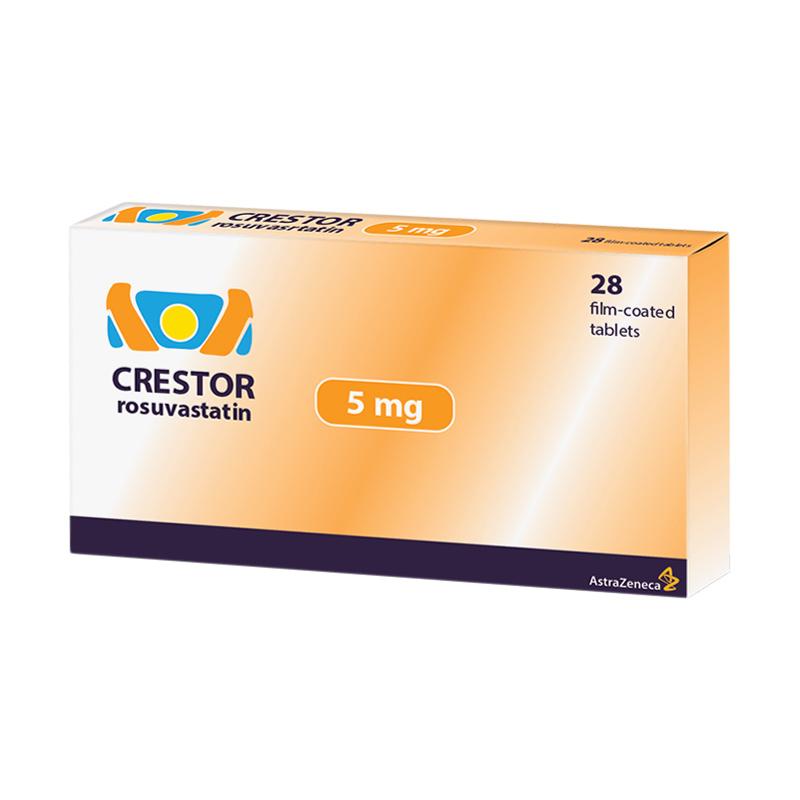Crestor is a prescription medicine that contains a cholesterol-lowering medicine called rosuvastatin calcium. The generic name is rosuvastatin. Most of the cholesterol in your blood is made in the liver. Crestor works by reducing cholesterol in two ways: Crestor blocks an enzyme in the liver causing the liver to make less cholesterol, and Crestor increases the uptake and breakdown by the liver of cholesterol already in the blood. It is recommended to be used together with dietary changes, exercise, and weight loss.It is taken by mouth.
Generic name : rosuvastatin
Brand names : Crestor, Ezallor, SprinkleNistrol, Oloduo, Recansa, Rosfion, Rostin, Rosufer, Rosupid, Roswin, Rovastar, Rovaster, Rovator, Rozact, Simrovas, Suvesco, Vastrol.
Drug Fact
Class : Statin
Category: Prescription Only
Uses: prevent cardiovascular disease in those at high risk and treat abnormal lipids
Consumed by: adults and children
Pregnancy category: X
Category X: Studies in animals or human beings have demonstrated fetal abnormalities or there is evidence of fetal risk based on human experience or both, and the risk of the use of the drug in pregnant women clearly outweighs any possible benefit. The drug is contraindicated in women who are or may become pregnant.
Dosage form: tablet
Side effects:
Muscle pain, tenderness and weakness (myopathy). Muscle problems, including muscle breakdown, can be serious in some people and rarely cause kidney damage that can lead to death. Tell your doctor right away if:
you have unexplained muscle pain, tenderness, or weakness, especially if you have a fever or feel more tired than usual, while you take Crestor.
you have muscle problems that do not go away even after your doctor has told you to stop taking Crestor. Your doctor may do further tests to diagnose the cause of your muscle problems.
Hepatic Impairment
Active liver disease: Contraindicated.
Administration
May be taken with or without food.
Contraindications
Active liver disease, including unexplained, persistent elevations of serum transaminases; myopathy. Severe renal impairment (CrCl <30 mL/min). Pregnancy and lactation.
Special Precautions
Patient with hypothyroidism; history of hereditary muscular disorders or muscular toxicity with another HMG-CoA reductase inhibitor or fibrates; excessive alcohol consumption, history of liver disease, severe respiratory failure. Patients of Asian ancestry, those with predisposing factors to myopathy or those taking concomitant ciclosporin, gemfibrozil, atazanavir/ritonavir, lopinavir/ritonavir, or simeprevir. Patient with SLCO1B1 and ABCG2 polymorphism. Moderate renal impairment (CrCl 30-60 mL/min). Children and elderly.
Adverse Reactions
Significant: Myopathy, myalgia, diabetes mellitus, haematuria, proteinuria, interstitial lung disease, liver enzyme abnormalities, increased creatine phosphokinase levels.
Blood and lymphatic system disorders: Rarely, thrombocytopenia.
Gastrointestinal disorders: Abdominal pain, constipation, nausea.
General disorders and administration site conditions: Asthenia.
Hepatobiliary disorders: Rarely, pancreatitis, hepatitis, jaundice.
Immune system disorders: Hypersensitivity (e.g. angioedema).
Musculoskeletal and connective tissue disorders: Rarely, arthralgia, muscle rupture, Lupus-like syndrome.
Nervous system disorders: Dizziness, headache, peripheral neuropathy.
Psychiatric disorders: Depression, sleep disorders (e.g. insomnia, nightmares).
Reproductive system and breast disorders: Rarely, gynaecomastia.
Skin and subcutaneous tissue disorders: Pruritus, rash, urticaria.
Potentially Fatal: Rarely, rhabdomyolysis with acute renal failure secondary to myoglobinuria, hepatic failure.
Pregnancy Category (US FDA)
PO: X
Monitoring Parameters
Obtain lipid panel (HDL, LDL, total cholesterol, triglycerides) prior to therapy, then every 4-12 weeks after initial therapy and every 3-12 months thereafter; LFT prior to therapy and as needed thereafter; creatine phosphokinase when myopathy is considered or in high-risk patients.
Drug Interactions
Increased exposure with certain protease inhibitors (e.g. ritonavir-boosted regimens, simeprevir), gemfibrozil, ezetimibe, ciclosporin, colchicine. Decreased plasma concentration with Al- and Mg-containing antacids, erythromycin. May increase INR when given with vitamin K antagonists (e.g. warfarin). May increase the plasma concentration of oral contraceptives. May increase risk of myopathy with concurrent use of strong CYP3A4 inhibitors (e.g. clarithromycin, itraconazole), fenofibrate, nicotinic acid.
Action
Description: Rosuvastatin selectively and competitively inhibits 3-hydroxy-3-methylglutaryl coenzyme A (HMG-CoA) reductase, the rate-limiting enzyme in cholesterol synthesis. It increases the number of hepatic LDL receptors on the cell surface, thereby enhancing the uptake and catabolism of LDL. It also decreases apolipoprotein B, triglyceride and increases HDL concentrations.
Onset: Within 1 week.
Pharmacokinetics:
Absorption: Incompletely absorbed from the gastrointestinal tract. Time to peak plasma concentration: 3-5 hours. Bioavailability: Approx 20%.
Distribution: Enters breast milk. Volume of distribution: 134 L. Plasma protein binding: Approx 90%, mainly to albumin.
Metabolism: Limited metabolism in the liver via CYP2C9 isoenzyme into N-desmethyl (approx 50% less active) and lactone metabolites (inactive).
Excretion: Via faeces (approx 90%, mainly as unchanged drug); urine (approx 5%, as unchanged drug). Elimination half-life: Approx 19 hours.
Chemical Structure
Storage
Store between 20-25°C. Protect from moisture.
ATC Classification
C10AA07 - rosuvastatin ; Belongs to the class of HMG CoA reductase inhibitors. Used in the treatment of hyperlipidemia.



0 Comments